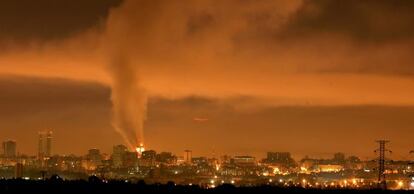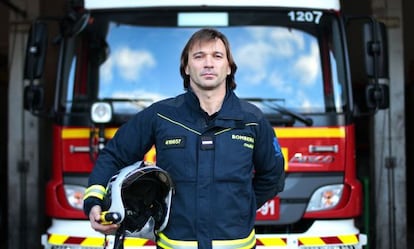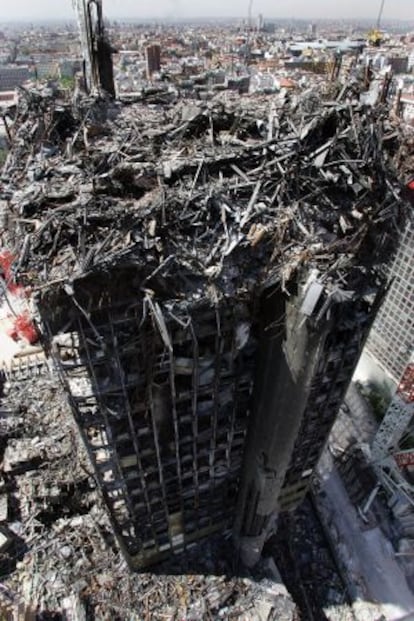Return to Madrid’s towering inferno
A firefighter who fought the blaze that destroyed the Torre Windsor relives the night The decade-old disaster spawned all manner of conspiracy theories

Anybody working in Madrid’s fire department a decade ago still remembers where they were on the night of February 12-13, 2005. One of them is José Antonio Gómez Milara, who found himself groping his way through burning debris and thick smoke without an oxygen mask on the 21st floor of the Torre Windsor skyscraper, which went up in flames that night.
It would take 36-year-old Milara and his comrades 26 hours to put out the blaze in the 106-meter-high building off the capital’s Paseo de la Castellana north-south boulevard. The disaster left behind a huge charred shell, along with numerous court cases. The official investigation never established the cause of the fire although an employee had been smoking in the offices of consultants Deloitte where the blaze started, and it was never cleared up whether there were people in the tower when the firefighters decided to empty it, as some amateur video footage shows. These and other unanswered questions have fed all kinds of conspiracy theories.
It was never established as to whether there were people in the tower after firefighters evacuated it, as video footage shows
The fire resulted in no deaths or serious injuries, but the repercussions spread far and wide. The prime minister at the time, José Luis Rodríguez Zapatero, visited the site, and all sorts of plans to improve security in the capital’s other skyscrapers were announced. Regional television station Telemadrid broadcast the blaze live, while private channel Telecinco attracted three million viewers to a special program it aired the next day. But despite enormous media pressure for those responsible to be identified and punished, a Madrid judge closed the case the following year after failing to find anybody to blame: neither the security measures nor the security staff tasked with guarding the building, nor the fire department were judged responsible, despite report after report pointing the finger at one or the other.
What is clear, however, is that on that night just about everything that could go wrong did.

The Saturday night shift had begun quietly enough at the nearby Santa Engracia fire station, with just a couple of callouts. But at 11.19pm, the alarm sounded, and the crew on duty headed off to number 65 Raimundo Fernández Villaverde street. On the way, they realized the address corresponded to the Torre Windsor, although at that point they could see no signs of fire from the building. When Milara arrived on the scene, the security team seemed largely unconcerned, and he told his colleagues: “Take it easy, it seems like nothing.”
But by the time he and his team reached the 21st floor, after having to walk up from the 18th, it soon became evident that the situation was rapidly getting out of control. While he and a colleague got their equipment ready, they were told by radio that the fire was now visible on the eastern side of the building. The two were the first to go up on to the 21st floor, advancing slowly, unable to see anything, guiding themselves by sticking to the right-hand wall, until the hosepipe would run no further. One firefighter was on his knees pointing the pipe into the inferno, while another stood by behind, the pair changing positions every few minutes. But the fire was already so fierce and the water pressure so weak that the water was evaporating virtually as it came out of the hose.

As more firefighters arrived – in total, 80 officers would be involved over the course of the blaze – Milara told a senior officer the problem. The two men went back into the building, but soon lost contact amid the smoke and burning debris. Milara reached another colleague who had lost his breathing apparatus, but the younger firefighter fainted, falling on to Milara, pulling his mask off in the process. “I felt a terrible blow, like a burning frying pan that just knocked me out,” he says. But he managed to make his way back out with the other firefighter, his uniform already smoldering. “When I got out, I just wanted them to get my clothes off me.”
He was taken to a field hospital set up outside the building, but after a few minutes he had found himself new breathing equipment and was back with his colleagues waiting in the entrance to the building ready to fight the blaze. The next day, medics would tell him that he had severely burned his respiratory system, causing irreparable damage to his lungs.
The commanding officer had issued an order for the firefighters to gather in the entrance: five officers were already trapped on the upper floors and were at serious risk. For the moment, the water pressure was insufficient to make any impact on the rapidly spreading fire. A new strategy was required. Once all the firefighters were accounted for and back downstairs, teams began walking up the stairway. “It was very laborious, we were already tired and the equipment we were carrying weighed 30 kilograms.” They trudged up in silence, warily noting that the concrete stairs were beginning to crack. At the 14th floor, they heard an enormous bang, and were told to return. The team monitoring the situation on the ground had decided to evacuate the building due to the risk of collapse. The fire would have to be controlled from outside. By now it was 1am on the morning of February 13.
Video: Live TV coverage of the blaze in February 2005 (Spanish narration).
The bang had been caused by the collapse of a huge exterior emergency stairway. It had fallen in the direction of where a number of officials, including the city’s then-mayor, Alberto Ruiz-Gallardón, were monitoring the blaze, forcing them to take cover. Security chief Pedro Calvo says he and the mayor had no doubts about following the advice of the firefighters in not risking any lives to put out the blaze. “But the feeling was one of complete powerlessness,” he says.
Aside from the risk of the building collapsing, the other major danger came from a construction crane on the roof – part of work to improve fire safety. Built in 1979, the Torre Windsor did not meet the construction norms of the day, mainly because it was not compartmentalized: the façade was a single piece, from top to bottom, and was one of the reasons why the fire spread so quickly, says Vicent Pons, the technical expert brought in by insurer Allianz. “What’s more, the building was pretty much a paper storage warehouse,” he adds, referring to the huge amounts of documents kept there. Pons disagreed with the firefighters’ strategy to give up on trying to control the blaze and instead take measures to prevent it from spreading to neighboring structures: the seven-story El Corte Inglés department store was next door. Milara, who worked through the night until 8am on the morning of February 13, praises his bosses’ decision: “It was very brave,” he says, with regard to the pressure from the media, which was broadcasting the disaster live, as well as the importance of the building.
“For two months afterwards I was on antibiotics and oxygen treatment,” he says. Until the blaze, he was an accomplished athlete, and had won many medals in regional police and firefighting competitions. It took many months for him to recover his health, and he was unable to walk any distance at any speed without provoking racking coughing, often bringing up small pieces of charred dust. A decade on, the night of February 12-13, remains branded on the memory of all Madrid’s firefighters.
Conspiracy theories
A Madrid court ruled in 2006 that the Torre Windsor fire was not started deliberately, but failed to establish the cause. An employee of consultancy Deloitte had been working until 11.30pm in the office where the fire started. She had been smoking, but the court ruling stated that there was no evidence to connect “the consumption of cigarettes” and “the origin or propagation of the fire,” “except within the ambit of conjecture.”
The court ruling also mentioned an amateur video taken of the building during the blaze that appears to show people on the 12th floor of the tower at around 3.30am, more than two hours after firefighters had ordered the building to be evacuated.
“I saw lights and people moving around, so I asked my wife to film it,” says Carlos Just, an out-of-town lawyer who was spending the weekend with family. His wife, Enriqueta, took the images, which were soon broadcast by several television stations. “We called the emergency services, and they told us they were firefighters, so we didn’t give it any more thought,” says Just.
But Madrid’s fire department subsequently denied that any of its officers were in the building at the time of the video recording. There was speculation that it might have been manipulated, or that the figures were simply shadows or reflections from nearby buildings. But police forensic specialists later said that the figures were real, and the judge accepted this. Three underground entry points had remained open during the blaze. The judge overseeing the investigation said that even if people had made their way into the building, “this could have had no impact on the cause or propagation of the blaze.”
Speculation on whether the fire was started deliberately, as well as what some companies with offices in the building might have tried either to save or destroy has continued to this day. The finger of suspicion has been pointed at Comparex España, a company with links to the Spanish Defense Ministry, as well as to Deloitte itself, which was handling the papers relating to an audit of FG Valores, a company sold by BBVA bank to Merrill Lynch in 1996 that was under investigation by anti-corruption prosecutors. BBVA says that copies of all the paperwork are available from the National Stock Exchange Commission.
The civil case, which related to some €200 million in compensation, was closed in 2011 via an out-of-court settlement between Deloitte, Prosegur, and El Corte Inglés department store. The retailer bought the site previously occupied by the Torre Windsor. Today, it is occupied by the 104-meter-high Torre Titania, and includes an extension of the store on the lower floors, with company office space on the upper stories. Of the Torre Windsor, there remains no trace.
Tu suscripción se está usando en otro dispositivo
¿Quieres añadir otro usuario a tu suscripción?
Si continúas leyendo en este dispositivo, no se podrá leer en el otro.
FlechaTu suscripción se está usando en otro dispositivo y solo puedes acceder a EL PAÍS desde un dispositivo a la vez.
Si quieres compartir tu cuenta, cambia tu suscripción a la modalidad Premium, así podrás añadir otro usuario. Cada uno accederá con su propia cuenta de email, lo que os permitirá personalizar vuestra experiencia en EL PAÍS.
¿Tienes una suscripción de empresa? Accede aquí para contratar más cuentas.
En el caso de no saber quién está usando tu cuenta, te recomendamos cambiar tu contraseña aquí.
Si decides continuar compartiendo tu cuenta, este mensaje se mostrará en tu dispositivo y en el de la otra persona que está usando tu cuenta de forma indefinida, afectando a tu experiencia de lectura. Puedes consultar aquí los términos y condiciones de la suscripción digital.
Últimas noticias
Maduro pleads not guilty before the federal court in New York: ‘I am still the president of Venezuela’
A new test can detect Alzheimer’s from a finger prick
UN team enters Sudanese city of El Fasher after paramilitary massacre: ‘It’s like a ghost town’
A recipe for resistance: Indigenous peoples politicize their struggles from the kitchen
Most viewed
- Gilles Lipovetsky: ‘If you want to live better and fall in love, take Prozac, don’t look to philosophy’
- Alain Aspect, Nobel laureate in physics: ‘Einstein was so smart that he would have had to recognize quantum entanglement’
- Alvin Hellerstein, a 92-year-old judge appointed by Bill Clinton, to preside over Maduro’s trial in New York
- Maduro’s downfall puts China’s relationship with Venezuela to the test
- Why oil has been at the center of Venezuela-US conflicts for decades









































